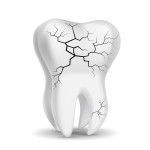When you can’t save your tooth – extraction
 Sometimes a tooth is too badly broken, decayed or sick to be saved by any other measure, and tooth removal is the only option to regain a healthy oral environment.
Sometimes a tooth is too badly broken, decayed or sick to be saved by any other measure, and tooth removal is the only option to regain a healthy oral environment.
When you just don’t have room for your teeth – elective extraction
Modern humans have evolved to have smaller jawlines, and all the teeth we own just don’t fit. For most of us that plays out in the wisdom tooth area. Space does not exist for proper eruption, function, and cleaning of these teeth which can lead to the potential for more decay, gum issues, and infection throughout life. Removal is usually encouraged early in life when health is good and healing is uncompromised.
Sometimes orthodontic care is desired and teeth are needed to be removed to alleviate excess cosmetic crowding. If part of your orthodontic plan, selective elective tooth removal can get you to that smile you desire.
What is an extraction?
Tooth extraction is the removal of the entire tooth including the roots from the supporting bone of the jaw. Our body responds by remodeling the bone and filling in the space that was previously occupied by the roots. In time this allows good support for replacement strategies such as implants, bridgework, or dentures in the future
Signs, symptoms and factors leading to tooth extraction
Any one or a combination of these signs/symptoms/circumstances may indicate a need for tooth removal
- Severe temperature, biting, pressure or aching feelings that indicate an infected nerve
- No desire or means to save a tooth through root canal therapy or gum therapy
- Extensive trauma
- Substantial tooth decay making the tooth non restorable
- Advanced gum disease
- Badly cracked or broken teeth
- Teeth that don’t fit in the mouth- orthodontic reasons
- Wisdom teeth, especially when incompletely erupted
Can I use antibiotics?
Teeth with advanced stages of dental disease usually have infected pulp tissue inside the tooth and /or bacterial infection on the outside of the tooth in the case of gum disease. This tends to make your immune system treat this original part of your body now as a foreign object, much like a sliver in your finger.
Antibiotics might decrease your symptoms for a short time, but symptoms will continue to return until the real cause of the problem, your tooth issue, is resolved.
Tooth Removal Procedure
The idea of having teeth removed is scary to some. Don’t worry though, with our gentle techniques and pain free offerings, you have nothing to fear.
- The area around the target tooth is numbed and isolated for the procedure
- The area is prepared for good visual access to all parts of the tooth to be removed
- The tooth is removed entirely
- The site is closed to allow maximal healing
- Post-operative care is discussed
Tooth Removal Post Op Instructions (pdf)
What are the benefits of tooth removal?
Overall these procedures are performed to achieve the best oral health for the circumstances
- Relief of pain and other symptoms
- Removal of infectious source from your body
- In the short term most cost effective (not considering replacement teeth)
Don’t continue to live in pain or let you fears get the better of you. Call Generations Dental and let Dr. Jim and Dr. Kelly give you some relief in a comfortable pain free environment. We are also available to aid you in any type of tooth replacement strategy.
As always we are happy to discuss how this health saving procedure can be worked into your lifestyle, and budget.
